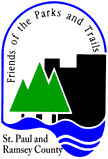by Cindy Schwie
Imagine a warm sunny day, with clear blue skies, peace and quiet while overlooking the magnificent Mississippi River. What more could anyone seeking a quiet spot in an urban setting ask for? At first, most of us would say nothing. However, appearances can be deceiving. Remember I said imagine. In many places along the river bluff in St. Paul, Minnesota all a hopeful observer can do is imagine a great view. Visitors to the river bluff will notice that in many areas they cannot see the river below because an impenetrable wall of unnatural vegetation exists. Our fragile, diverse river bluff is slowly giving way to an emerging monoculture dominated by aggressive exotic species.
In 1999, Friends of the Parks and Trails of St. Paul and Ramsey County (Friends) received funding for a 36-month grant from the Legislative Commission on Minnesota Resources (LCMR). The grant specifically seeks to restore ecological health by removing exotic species and replenishing with native species; thereby, increasing diversity of plant life, slowing erosion, and ultimately creating a healthier sustainable ecosystem. One of the culprits for the increasing loss of diversity, erosion and reduction of native plant species on the river bluff is buckthorn.
Common buckthorn is native to Eurasia and is an aggressive exotic species. First introduced in North America in the 1700’s, it has invaded woodlands and savannas at an alarming pace. Partial responsibility is attributed to the composition of the buckthorn berries. Each berry accommodates 3 – 4 seeds all of which contain a chemical diuretic, which in turn causes a severe laxative effect. Needless to say, when birds eat the berries, the seeds are dispersed rather quickly! Buckthorn is also very hardy due to its tolerance of both shade and drought. When droughts occur and native trees die out, buckthorn is able to move in and quickly establish itself, thereby, effectively prohibiting the regrowth of native trees and plants.
There are three main objectives for our project. The objectives are to remove the invasive exotics and replant with native species, to educate citizens about aggressive exotic species such as buckthorn, and finally to establish a management plan outlining strategies to keep the river bluff ecologically healthy after the grant period has ended.
The first objective is to remove the exotic invasive species, and replenish with native plant life in areas prone to erosion. In order to accomplish this, an inventory will be taken of all exotic, native, and rare plant species. The inventory provides a “blueprint” for removal efforts and future planting strategies for native species. It also creates a formal record for rare plant species. The project area is unique in that St. Paul has the longest stretch of river bluff of any community along the Mississippi River.
The second objective of the grant is to educate the community bordering the river bluff about the problems associated with keeping exotic species on their property. It is understandable that relatives from past generations may have planted buckthorn hedges. For many families, the hedges may be a part of their history. It is our hope that residents will realize that when grandma and grandpa built the family home close to the river bluff it was because they felt the river was a treasure, something for their family to enjoy. Had they known of the threat to the ecosystem along the river, I highly doubt they would have planted buckthorn. If neighboring residents remove invasives such as buckthorn, it will make the task of keeping the river bluff exotic-free a less labor-intensive effort in the years to come.
The third objective is to develop a comprehensive management plan as a guideline for ongoing ecological health on the river bluff after our project is completed. The management plan will be distributed to communities in close proximity to the project area as a “blueprint” for maintaining ecological health. We understand that merely removing, replanting and restoring is not enough. It is also necessary to devise an ongoing plan to sustain the river bluff for future generations.
With all of this said, recently I was asked the following question. “Why would I encourage homeowners to remove a shrub that provides a habitat and food for the birds.” I replied, “How would you feel if you went to your favorite restaurant and opened the menu only to find one item listed.” They said, “That would be ridiculous! A menu with no choices!” I said, “The same is true for nature.” Buckthorn is rapidly eliminating choices! Without diversity, ecological health and sustainability are as fleeting as the view of the Mississippi on that beautiful, warm sunny day.
Click here for a print version of this article (pdf).
